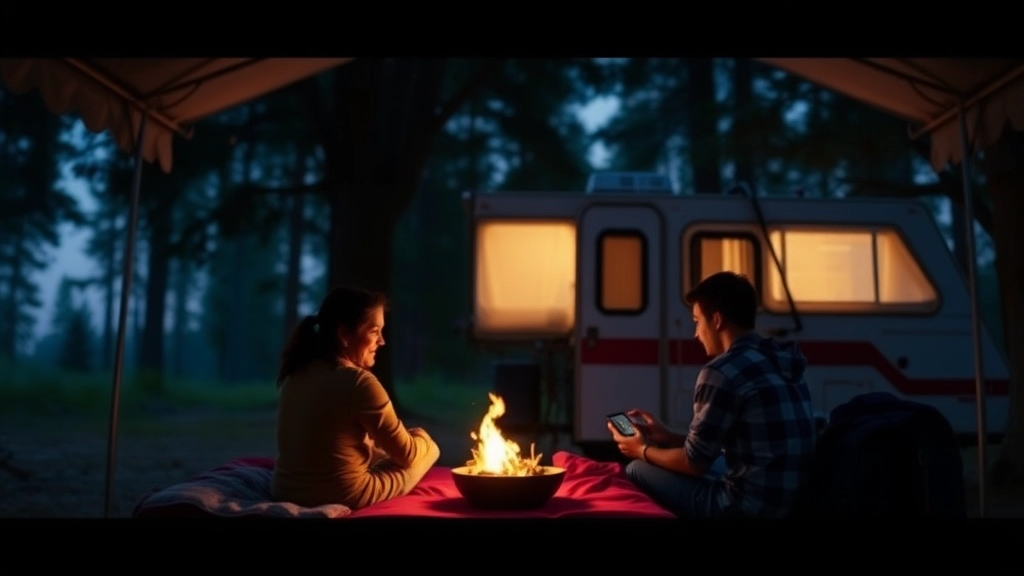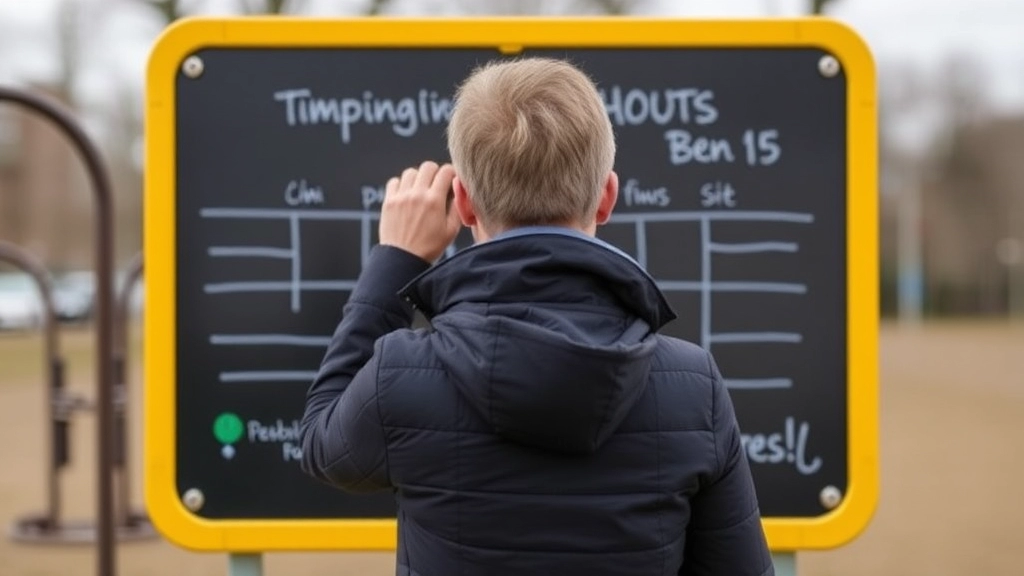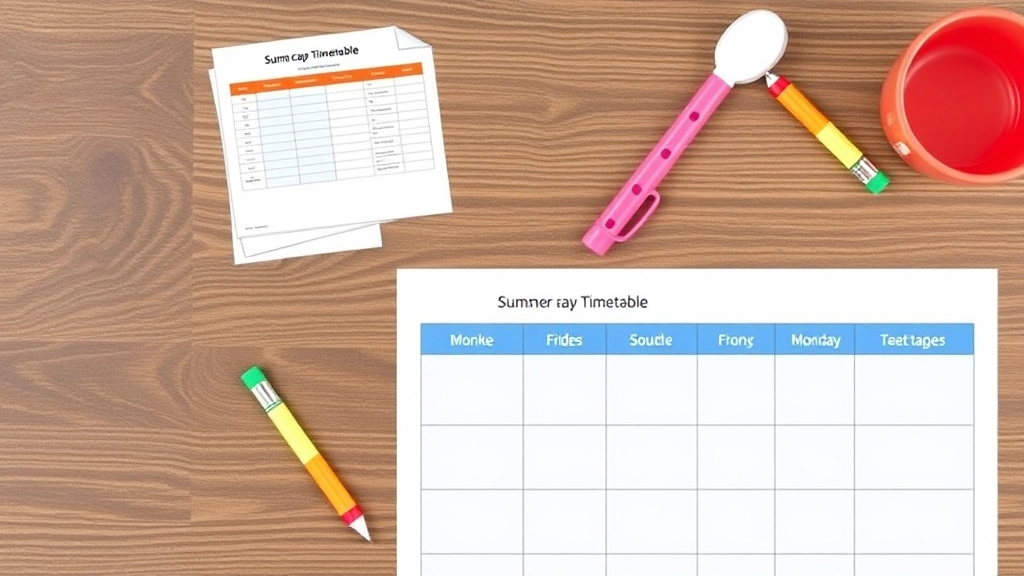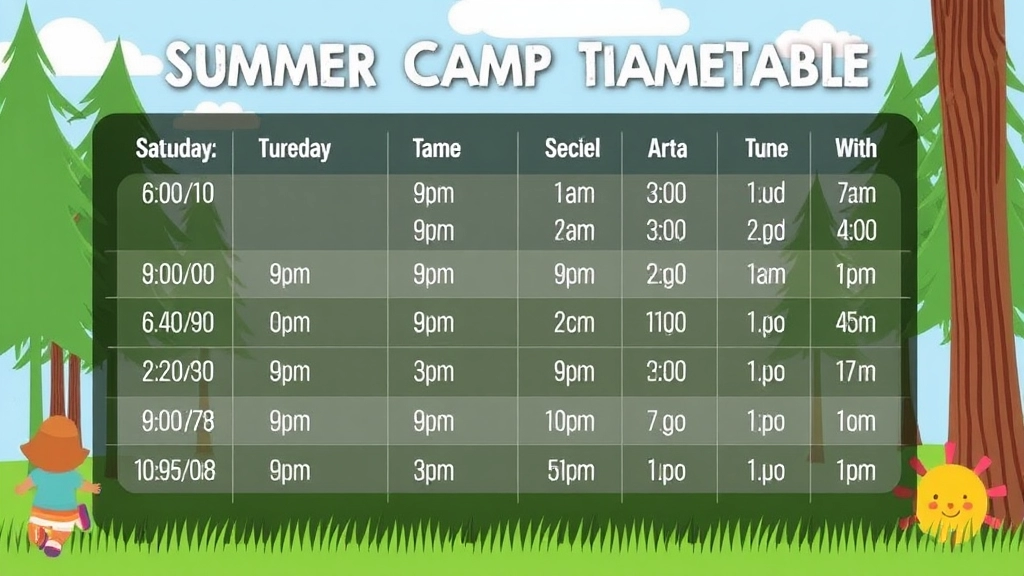Planning a summer camp timetable can feel like a juggling act, but with the right strategies, it can be a breeze. This article dives into the essential elements of a summer camp timetable, from structuring daily activities to incorporating physical, mental, and creative tasks. We’ll explore how to schedule rest and free time, organize activities by age group and skill level, and handle unpredictable factors like weather changes. Plus, we’ll discuss the importance of weekly themes, special events, and tools that can simplify your planning process.
Flexibility and backup plans are crucial for a smooth camp experience, and we’ll show you how to integrate them effectively. Communication with parents is another key aspect, ensuring they feel connected and informed. Safety protocols and emergency time slots are non-negotiable, and we’ll cover how to implement them seamlessly. Whether you’re a seasoned camp organizer or a newbie, this guide offers practical tips and real-life examples to help you create a fun, engaging, and safe summer camp timetable.
Identifying Key Elements of a Summer Camp Timetable
Alright, let’s dive straight into it. Summer camp timetables can be a real headache if you don’t know where to start. But don’t worry, I’ve got you covered. The key elements of a summer camp timetable are like the secret sauce to making sure everything runs smoothly. So, what are these key elements?
Core Activities
First off, you need to pin down your core activities. These are the backbone of your camp. Think swimming, hiking, arts and crafts, and team sports. These are the activities that kids sign up for and look forward to. Make sure you’ve got a good mix to keep everyone engaged.
Time Slots
Next up, time slots. You can’t just throw activities on a board and hope for the best. You need specific time slots to make sure everything fits together like a puzzle. Typically, you’ll have:
- Morning Sessions: High-energy activities to kickstart the day.
- Afternoon Sessions: More relaxed or creative activities.
- Evening Sessions: Wind-down activities like campfires or storytelling.
Age Groups
Different age groups, different needs. A 6-year-old and a 14-year-old aren’t going to be interested in the same things. Split your timetable by age groups to keep activities age-appropriate and engaging.
Skill Levels
Skill levels are crucial. Not every kid is going to be a pro at archery or a born artist. Have beginner, intermediate, and advanced sessions for various activities. This way, everyone feels included and challenged.
Rest and Free Time
Kids need downtime. It’s non-negotiable. Schedule in rest periods and free time to let them recharge. This also gives them a chance to socialise and make friends.
Safety Protocols
Safety first, always. Make sure your timetable includes time for safety briefings and emergency drills. This isn’t just about ticking a box; it’s about ensuring everyone knows what to do in case of an emergency.
Parental Check-Ins
Parents want to know what’s going on. Schedule regular check-ins or updates. Whether it’s a quick email, a phone call, or even a social media post, keep the lines of communication open.
Flexibility
Last but definitely not least, be flexible. Weather changes, kids get tired, and sometimes things just don’t go as planned. Have backup activities and be ready to pivot.
Real-Life Example:
Imagine you’re running a summer camp and it suddenly starts raining cats and dogs. You had an outdoor scavenger hunt planned. What do you do? Having an indoor backup activity like a treasure hunt in the main hall can save the day.
For more tips on ensuring a fun and safe camp experience, check out our essential guidelines for summer camp safety. And if you’re looking for creative activities to keep kids engaged, don’t miss our free printables for summer camp adventures.
Structuring a Day at Camp: Morning, Afternoon, and Evening Activities

Ever worried about how to keep kids engaged all day at camp?
I get it.
We’ve all been there.
A well-structured day at camp can make all the difference.
Let’s break it down.
Morning Activities
Kickstart the Day Right
Mornings are prime time for energy-packed activities.
We want to get their blood pumping and brains buzzing.
Here’s how:
- Wake-Up Routine: Stretching, light exercises, or a fun dance-off.
- Breakfast: Nutritious and filling. Think eggs, fruits, and whole grains.
- Morning Meeting: Set the tone. Go over the day’s plan and hype them up.
Afternoon Activities
Keep the Momentum Going
Afternoons can be tricky.
Kids might feel a dip in energy.
So, mix it up:
- Physical Activities: Sports, swimming, or obstacle courses. Keep them moving.
- Creative Time: Arts and crafts, music, or drama. Let their creativity flow.
- Lunch: Balanced meal. Think proteins, veggies, and carbs.
Evening Activities
Wind Down but Stay Engaged
Evenings should be a blend of relaxation and fun.
We want them to end the day on a high note:
- Quiet Time: Reading, journaling, or board games.
- Group Activities: Campfire stories, talent shows, or movie nights.
- Dinner: Comfort food. Think pasta, salads, and some treats.
Real-Life Example
Remember that time when we had a surprise rainstorm?
Our well-structured day saved us.
Morning sports turned into indoor games.
Afternoon crafts became a hit.
Evening stories by the fireplace made it memorable.
Pro Tips for a Smooth Day
- Flexibility is Key: Always have backup plans.
- Balance is Essential: Mix physical, mental, and creative activities.
- Rest Time: Schedule breaks. Kids need downtime.
Incorporating Physical, Mental, and Creative Activities
Alright, let’s get real. How do you keep kids engaged at summer camp without them zoning out or bouncing off the walls? The secret sauce is a mix of physical, mental, and creative activities. You need to strike that balance to keep everyone happy and thriving.
Physical Activities: Burn Off That Energy
Kids have energyâloads of it. And if they don’t burn it off, you’ll have chaos. So, let’s dive into some physical activities that are sure to keep them moving and grooving:
- Sports and Games: Think football, basketball, or even a game of tag. These aren’t just fun; they teach teamwork and coordination.
- Obstacle Courses: Set up a course with ropes, tires, and balance beams. It’s like a mini adventure that challenges their physical limits.
- Swimming: If your camp has a pool, use it. Swimming is a great full-body workout and a fantastic way to cool down on hot days.
Mental Activities: Keep Those Minds Sharp
Physical activity is great, but you don’t want their brains turning to mush over the summer. Here’s how to keep their minds engaged:
- Puzzles and Brain Teasers: Simple yet effective. Think crosswords, Sudoku, or scavenger hunts.
- Educational Workshops: Bring in experts for short sessions on interesting topicsâastronomy, wildlife, or even basic coding.
- Reading Time: Set aside a quiet period where kids can dive into books. It’s a great way to wind down and stimulate their imaginations.
Creative Activities: Let Their Imaginations Run Wild
Kids are naturally creative. Give them the tools and the freedom to express themselves, and you’ll be amazed at what they come up with:
- Arts and Crafts: From painting to sculpting to making friendship bracelets. It’s hands-on and lets their creativity shine.
- Drama and Music: Organize small skits or musical performances. It builds confidence and public speaking skills.
- Writing and Storytelling: Encourage them to write short stories or poems. It’s a wonderful way to express their thoughts and feelings.
Real Talk: Balancing It All
You might be thinking, “How do I fit all this into one day?” Here’s a quick breakdown:
Scheduling Rest and Free Time for Campers

Alright, let’s dive into something every camper (and camp organiser) needs but often overlooks: rest and free time.
Why is Rest Important?
Ever seen a kid totally wiped out by midday? Yeah, that’s why.
Rest isn’t just about avoiding cranky kids. It’s about giving their bodies a chance to recover and their minds a breather.
Here’s the deal:
- Physical Recovery: All those games and activities? They take a toll.
- Mental Reset: Constant stimulation can lead to burnout. A bit of downtime helps them process everything.
When to Schedule Rest
You can’t just sprinkle rest like fairy dust. You need to be strategic.
- Mid-Morning Break: After a couple of hours of activities, a 15-20 minute break works wonders.
- Post-Lunch Chill: This is crucial. A full stomach and a tired body need a good 30-45 minutes to recharge.
- Evening Wind-Down: Before bed, some quiet time helps kids transition smoothly into sleep.
Free Time: The Secret Sauce
Free time is different from rest. It’s unstructured, but it’s gold.
Why?
- Creativity Boost: Kids get to explore their interests.
- Social Skills: They learn to interact without adult direction.
- Independence: Making their own choices builds confidence.
How to Fit Free Time In
You don’t need to block out hours. Small pockets work just fine.
- Morning Flex Time: After breakfast but before the first activity.
- Afternoon Play: Post-lunch but pre-structured activities.
- Evening Leisure: After dinner, before the evening event.
Balancing Rest and Free Time
It’s a dance. Too much rest and they’re bored. Too little and they’re exhausted.
Here’s a quick guide:
- Morning: Short rest, followed by some free play.
- Afternoon: Longer rest, then a bit of free time.
- Evening: Short rest, then free time leading into bedtime.
Real Talk: What Do Parents Worry About?
Parents often fret about their kids being too tired or too idle.
Address these worries head-on:
- Assure them: Explain how rest and free time are built into the schedule.
- Show examples: Share past success stories or testimonials.
- Be transparent: Provide a sample timetable.
Organising Camp Schedules by Age Group and Skill Level
Ever wondered how to keep a bunch of kids of different ages and skill levels entertained and engaged at a summer camp? Trust me, it’s a real challenge, but it’s totally doable. Let’s break it down.
Why It’s Crucial to Tailor Schedules by Age and Skill
First off, kids aren’t all the same. What works for a 6-year-old will bore a 12-year-old to tears. And a beginner swimmer won’t thrive in an advanced swimming class. So, organising camp schedules by age group and skill level is non-negotiable.
Real Concerns from Camp Organisers
- How do I ensure every camper is engaged?
- What if some kids feel left out or overwhelmed?
- How do I balance skill-building with fun?
These are legit worries. The key is to create a timetable that’s flexible yet structured. Let’s dive into the nuts and bolts.
Breaking Down the Age Groups
Young Kids (Ages 5-7)
- Activities: Simple crafts, basic sports, storytime
- Schedule: Shorter activity blocks, more frequent breaks
- Example: Morning – arts and crafts; Afternoon – nature walk
Middle Kids (Ages 8-10)
- Activities: Team sports, intermediate crafts, science projects
- Schedule: Balanced activity blocks with some free time
- Example: Morning – soccer; Afternoon – DIY science experiment
Older Kids (Ages 11-13)
- Activities: Advanced sports, leadership games, tech workshops
- Schedule: Longer activity blocks, more complex tasks
- Example: Morning – coding class; Afternoon – basketball tournament
Teens (Ages 14-17)
- Activities: Leadership training, advanced tech, community service
- Schedule: Flexible, with a focus on skill-building and independence
- Example: Morning – leadership workshop; Afternoon – volunteer project
Skill Level Considerations
Even within age groups, skill levels can vary widely. Here’s how to handle it:
- Beginner: Basic, introductory activities with lots of guidance.
- Intermediate: More challenging tasks that build on existing skills.
- Advanced: Complex projects and leadership roles.
Practical Tips for Smooth Scheduling
- Colour Code: Use different colours for different age groups and skill levels on your timetable.
- Flex Time: Include flexible periods where kids can choose activities based on their interests.
- Feedback Loop: Regularly check in with campers to see what’s working and what’s not.
Stories from the Field
I remember one summer, we had a group of 10-year-olds who were super into science. We started with basic experiments, but they quickly advanced. So, we adjusted their schedule to include more complex projects like building simple robots. They loved it, and it kept them engaged all summer.
Tools to Make Your Life Easier
- Google Sheets or Excel: For creating and adjusting timetables easily.
- Camp Management Software: Some tools are specifically designed for camp scheduling.
- Templates: Pre-made templates can save you tons of time.
Handling Weather Changes and Unpredictable Factors in Timetables

Ever had a summer camp day planned out perfectly, only for the weather to throw a wrench in the works?
Yeah, we’ve all been there.
Weather changes and unpredictable factors can mess up even the best-laid plans.
But don’t worry, I’ve got some tips to help you stay ahead of the game.
Be Ready with Backup Activities
First things first, always have a Plan B.
If it rains, can you move that outdoor activity indoors?
Maybe swap out the hike for a board game tournament or a storytelling session.
Here are some quick ideas:
- Indoor treasure hunts: Keep the adventure alive without stepping outside.
- Craft sessions: Simple, fun, and keeps everyone engaged.
- Movie time: Educational films or just a fun flick to keep spirits high.
Flexible Spaces
Think about the spaces you’re using.
Can the dining hall double as an activity room?
Is there a covered area where kids can still run around safely?
Having multi-use spaces can save the day.
Real-Time Weather Updates
Keep an eye on the weather.
Use apps or websites that give real-time updates.
If you know a storm is coming, you can adjust the schedule before it hits.
Communicate with Your Team
Make sure everyone knows the backup plan.
Quick meetings in the morning can set the tone for the day.
If things change, everyone should be on the same page.
Engage the Kids
Sometimes, the best ideas come from the kids themselves.
Ask them what they’d like to do if plans change.
You might be surprised by their creativity.
Real-Life Example
Last summer, we had a sudden downpour during our outdoor sports day.
Instead of cancelling, we moved the activities to the gym.
We ended up having an epic indoor Olympics, complete with obstacle courses and relay races.
The kids loved it, and it turned out to be one of the highlights of the camp.
Stay Positive
Your attitude sets the tone.
If you’re flexible and upbeat, the kids will follow your lead.
Remember, the goal is to make sure everyone has a great time, no matter the weather.
Weekly Themes and Special Events Integration
Ever wondered how to keep a summer camp exciting and engaging for kids? Let’s talk about weekly themes and special events integration. This is where the magic happens, transforming a regular camp experience into something unforgettable.
Why Weekly Themes?
Imagine being a kid again. Wouldn’t it be thrilling to have a pirate adventure one week and a science exploration the next? Weekly themes keep the camp fresh and exciting, ensuring that campers are always looking forward to what’s next.
Here’s why they work:
- Variety: Different themes prevent monotony and keep campers engaged.
- Focus: Themes give structure to activities, making it easier to plan and execute.
- Learning: Each theme can introduce new skills and knowledge in a fun way.
How to Choose Themes
Picking the right themes can make or break the camp experience. Here are some tips:
- Know Your Audience: What are the kids interested in? Superheroes, space, animals?
- Mix It Up: Balance between physical, mental, and creative themes.
- Seasonal Relevance: Tie themes to seasons or holidays for added excitement.
Examples of Weekly Themes
- Adventure Week: Treasure hunts, obstacle courses, and survival skills.
- Science Week: Experiments, nature walks, and star gazing.
- Art Week: Painting, crafts, and theatre performances.
- Sports Week: Different sports each day, mini-Olympics, and team-building games.
Integrating Special Events
Special events are the cherry on top. They break the routine and add an element of surprise. Here’s how to seamlessly integrate them:
- Plan Ahead: Schedule special events at the beginning of the camp.
- Tie to Themes: Coordinate events with the weekly theme for a cohesive experience.
- Variety of Events: From talent shows to guest speakers, keep it diverse.
Real-Life Example
Let me share a story. Last summer, we had a “Space Week” at our camp. We kicked off with a rocket-building workshop. Midweek, we had a stargazing night with telescopes. The grand finale? A visit from a real-life astronaut. The kids were over the moon, literally and figuratively.
Practical Tips for Integration
- Create a Calendar: Map out themes and events for the entire camp duration.
- Flexibility: Be ready to adapt if something doesn’t go as planned.
- Feedback: Get input from campers and staff to refine future themes and events.
For more ideas on structuring your camp activities, check out our Summer Camp Schedule & Activities Guide. If you need inspiration for creative projects, our Summer Camp Creative Arts and Crafts Ideas will spark your imagination.
Tools and Templates for Creating a Summer Camp Timetable

Ever tried putting together a summer camp timetable?
It’s like trying to juggle flaming torches while riding a unicycle.
But don’t stress.
I’ve got your back.
Let’s dive into the tools and templates that’ll make your life a whole lot easier.
Why You Need the Right Tools
First off, why bother with tools and templates?
Because winging it isn’t an option.
You need structure.
You need clarity.
You need something that won’t fall apart when you sneeze.
The Essential Tools
- Google Sheets or Excel:
- Perfect for creating and sharing your timetable.
- Easy to update in real-time.
- Colour-coding options to differentiate activities.
- Trello:
- For those who love visual planning.
- Drag and drop features.
- Assign tasks to team members, so everyone knows what’s up.
- Camp Management Software:
- Tailored specifically for camps.
- Features like automated scheduling, parent communication, and emergency alerts.
- Examples: CampMinder, Active Network.
Must-Have Templates
- Daily Schedule Template:
- Break down the day into morning, afternoon, and evening slots.
- Include time for meals, activities, and rest.
- Weekly Overview Template:
- Big picture view.
- Helps in planning weekly themes and special events.
- Ensures a balanced mix of activities.
- Emergency Plan Template:
- Because things can go south.
- Include emergency contacts, evacuation routes, and first aid procedures.
Real Questions Camp Organisers Face
- “How do I keep track of everything?”
- “What if it rains?”
- “How do I communicate changes to parents?”
Example: A Day in the Life of a Camp Timetable
Imagine it’s Monday morning.
You’ve got 30 kids, aged 8-12.
Here’s a snapshot of your day:
- 08:00 – 09:00: Breakfast and morning briefing.
- 09:00 – 10:30: Team-building games (think tug-of-war and obstacle courses).
- 10:30 – 11:00: Snack break.
- 11:00 – 12:30: Creative arts (painting, crafts).
- 12:30 – 13:30: Lunch.
- 13:30 – 15:00: Nature hike.
- 15:00 – 15:30: Rest and free time.
- 15:30 – 17:00: Swimming.
- 17:00 – 18:00: Dinner.
- 18:00 – 20:00: Evening campfire and storytelling.
Keep It Real, Keep It Flexible
No plan survives first contact with reality.
Weather changes.
Kids get tired.
Activities take longer than expected.
So, always have a backup plan.
And communicate with your team.
Importance of Flexibility and Backup Plans in Camp Scheduling
Ever been in the middle of a perfectly planned day at camp when, bam, the skies open up, and it starts pouring? Or maybe a group of campers just isn’t vibing with the activity you thought they’d love? Yeah, we’ve all been there. And that’s why flexibility and backup plans in camp scheduling are non-negotiable.
Why Flexibility Matters
Let’s be real: no matter how meticulously you plan, something will always go sideways. And that’s okay! The key is to expect the unexpected and have a game plan for when things don’t go as planned.
Here are some real questions and worries you might face:
- What if it rains during outdoor activities?
- What if campers get bored or disengaged?
- What if an activity takes longer or shorter than expected?
Backup Plans: Your Safety Net
When it comes to summer camps, think of backup plans as your safety net. They catch you when things fall apart. Here’s how you can set yourself up for success:
- Weather-Related Changes: Always have indoor activities ready to go. Think arts and crafts, indoor sports, or even a movie session.
- Camper Engagement: Have a list of quick, fun activities that can be pulled out at a moment’s notice. Games, quick challenges, or impromptu talent shows can work wonders.
- Time Management: If an activity is a hit and runs over time, have a flexible schedule that allows for shifts. Conversely, if something wraps up too quickly, have fillers ready.
Real-Life Example
Imagine you’re running an outdoor obstacle course, and halfway through, it starts raining cats and dogs. Instead of scrambling, you smoothly transition the campers to an indoor scavenger hunt. Not only do you save the day, but you also keep the energy high and the campers happy.
Tips for Flexible Scheduling
- Create Buffer Times: Insert small buffer periods between activities. This gives you wiggle room for any overruns or delays.
- Rotate Activities: Have a mix of activities that can easily be swapped out. If the weather changes, you can switch from outdoor to indoor without missing a beat.
- Staff Training: Ensure your staff is trained to handle changes smoothly. They should be able to adapt and keep the campers engaged, no matter what.
Flexibility and backup plans are your secret weapons in camp scheduling. They ensure that no matter what curveballs get thrown your way, you can keep things running smoothly. And trust me, the campers (and their parents) will thank you for it.
Planning for Parental Check-ins and Communication

Ever worried about how to keep parents in the loop while their kids are off having the time of their lives at camp?
You’re not alone.
Parents want to know their kids are safe, happy, and making memories.
So, let’s break down how to nail this.
Why Parental Communication Matters
First off, parental communication is huge.
It builds trust.
It eases anxiety.
And, it keeps everyone on the same page.
Key Elements of Effective Communication
- Regular Updates:
- Daily or weekly emails
- Photos and videos
- Highlights of activities
- Scheduled Check-ins:
- Pre-arranged phone calls
- Set times for video chats
- Emergency Contacts:
- Clear guidelines
- Quick response times
Tools to Use
- Email Newsletters: Easy to send, easy to read.
- Social Media Groups: Private Facebook groups or Instagram stories.
- Camp Apps: Dedicated apps for real-time updates.
Real-Life Example
Last summer, we had a mum who was super anxious about her kid being away for the first time.
We set up a daily photo update and a mid-week video call.
By the end of the week, she was thrilled and felt totally connected.
Making It Work
- Consistency: Stick to your schedule.
- Transparency: Be upfront about what parents can expect.
- Flexibility: Be ready to adapt if a parent needs more or less communication.
Ensuring Safety Protocols and Emergency Time Slots in Schedules
Ever wondered what happens if a camper gets hurt or if a storm rolls in unexpectedly?
Safety at summer camp isn’t just a box to tickâit’s the whole game.
Let’s dive into how to nail this.
Why Safety Protocols Matter
First off, safety protocols are your lifeline.
Without them, chaos reigns.
Here’s what you need:
- First aid stations: Strategically placed and fully stocked.
- Trained staff: Everyone should know CPR and basic first aid.
- Emergency contact lists: Always up-to-date and easily accessible.
Building Emergency Time Slots into Your Schedule
Think about it: What if something goes wrong?
You can’t just wing it.
That’s why emergency time slots are crucial.
Here’s how you do it:
- Buffer times: Add 15-30 minutes between activities.
- Flexible activities: Have a list of low-key options like board games or storytelling.
- Quick evacuation plans: Know your exits and meeting points.
Real-Life Example
Last summer, we had a sudden downpour.
Thanks to our emergency slots, we quickly shifted to indoor activities.
No one panicked, and the kids had a blast with impromptu arts and crafts.
Tools to Help You Out
- Google Calendar: For setting reminders and alerts.
- Walkie-talkies: For instant communication.
- Checklists: For daily safety checks. Make sure you have a comprehensive summer camp packing list to ensure nothing is forgotten.
FAQs on Summer Camp Timetable
What is the typical structure of a day at camp?
A well-structured camp day is divided into morning, afternoon, and evening activities. The morning usually starts with a wake-up routine, breakfast, and a morning meeting. Afternoons include physical activities, creative time, and lunch. Evenings are a mix of relaxation and fun, with quiet time, group activities, and dinner.
How important is rest and free time during camp?
Rest and free time are crucial for both physical recovery and mental reset. Scheduled rest periods prevent burnout, while free time boosts creativity, social skills, and independence.
How do you handle unpredictable factors like weather changes?
Always have a backup plan. Indoor activities such as treasure hunts, craft sessions, or movie time can replace outdoor activities. Flexible spaces and real-time weather updates are also essential.
What tools and templates can help in creating a camp timetable?
Google Sheets or Excel, Trello, and camp management software like CampMinder or Active Network are useful tools. Essential templates include daily schedules, weekly overviews, and emergency plans.
How do you keep parents informed during camp?
Effective parental communication includes regular updates through emails, photos, and videos, scheduled check-ins via phone or video calls, and clear emergency contact guidelines. Tools like email newsletters, social media groups, and camp apps can facilitate this.
What are some pro tips for ensuring a smooth camp day?
Flexibility is key, so always have backup plans. Balance physical, mental, and creative activities, and schedule rest times to ensure kids have downtime.
Can you give an example of a well-structured camp day?
Here’s a snapshot:
- 08:00 – 09:00: Breakfast and morning briefing.
- 09:00 – 10:30: Team-building games.
- 10:30 – 11:00: Snack break.
- 11:00 – 12:30: Creative arts.
- 12:30 – 13:30: Lunch.
- 13:30 – 15:00: Nature hike.
- 15:00 – 15:30: Rest and free time.
- 15:30 – 17:00: Swimming.
- 17:00 – 18:00: Dinner.
- 18:00 – 20:00: Evening campfire and storytelling.
What should I do if the weather changes unexpectedly?
Be prepared with indoor activities like board games, storytelling sessions, or craft projects. Utilize flexible spaces and keep an eye on real-time weather updates to adjust plans accordingly.
How can I ensure kids stay engaged throughout the day?
Mix physical activities with creative and mental tasks. Schedule regular breaks and ensure a variety of activities to keep the kids’ interest levels high.
What are some examples of backup activities for bad weather?
Indoor treasure hunts, craft sessions, and movie time are great alternatives to outdoor activities when the weather doesn’t cooperate.
How can I balance rest and free time during the camp day?
Strategically schedule rest periods in the mid-morning, post-lunch, and evening. Incorporate short pockets of free time after meals and before structured activities.
How do I address parental concerns about their kids at camp?
Assure parents by explaining how rest and free time are built into the schedule. Share past success stories and provide a sample timetable for transparency.
References
-
Structuring a Day at Camp: Morning, Afternoon, and Evening Activities
-
Scheduling Rest and Free Time for Campers
-
Handling Weather Changes and Unpredictable Factors in Timetables

